#writing advices
Text
writers, don’t delete that sentence you think isn’t good. have it saved in a separate folder where you can come back to later. because here’s the secret, more often than not, those sentences/paragraphs you hated ended up being not just good but great when you came back and reread them later.
and the reason you even disliked them at first is mostly because writing can understandably take a lot of energy from you, and when your brain is tired, it tricks you into hating your own creation and thinking that it’s bad, when it could in fact be a masterpiece.
#writing#writer#writers#writeblr#writing advices#writing tip#writing advice#writing tips#whump#whumpblr#ao3#archive of our own#writing inspiration#writing positivity#writing inspo#writing challenge#writing tropes#writing prompts#writing prompt#writing trope#whump tropes#whump trope#whump prompts#whump prompt#tropes#trope#prompt#prompts#angst#whump community
530 notes
·
View notes
Text
How to write well-developped characters - P.1
🥀 :: THE EMOTIONS
Each character in a story has a different way to interact with others and with events. It's important to develop the emotions of your characters so we can differentiate them.
But it's not as easy as "my character is someone who's really happy, so they will always smile and laugh !!" Think about a real person: maybe we can say someone is happy or outgoing, but they are not always smiling and happy over the top. Emotions are complex and humans have a variety of them; you can't just write emotions in your story where you think it will be cute.
SO. How to write emotions ?
Become your character. While writing, immerse yourself in their thoughts to understand them deeply. How would you react if you were at their place and if you were having their personality ?
Never name the emotion the character is experiencing; try to make the reader understand it with the character's non-verbal and actions. For example, do not write, "Emeri was angry. Frustration dominated him." Instead, write, "Emeri clenched his jaw and his heart stopped beating. How- How dare they ?! He wanted to scream, to destroy everything."
Ask yourself questions while writing. In the last example with the anger, the writer asks theirself, "Which physical sensations would my character feel if he was angry ?" so the readers can better feel the emotion.
Don't plan to have "emotion scenes" and "action scenes" in your story. Emotions are something you feel constantly. You can't just "pause" your characters' emotions for a moment, especially if you want the readers to find them relatable. Put happiness in kissing scenes, anger in battle scenes and sorrow in death scenes.
Some tips to become better
Practice with other characters already written; put them in strange situations. How the Weasley family, in Harry Potter, would react if they had to buy food in a Muggles' shop ?
Deeply develop your characters. Give them a past, ambitions, interests, hobbies, etc. More they will seem humans, more it will be easier to write emotions.
Don't forget your characters evolve with the story so they may feel later different things for an event that happens in the beginning.
Draw inspiration from your personal experiences and emotions.
#writing#books & libraries#books and literature#books#reading#story#writing tips#writing advices#characters#dark academia#🤓
13 notes
·
View notes
Note
I need some advice from an expert, I mean, you; my head is full of ideas but when I want to express them they just don't come out, all the motivation I feel is lost the moment I start writing. I was wondering if this has happened to you and if you have any idea how to fix it. Thank you for your time and for writing such good stories.
sorry again for answering this so late! i’m far from an expert — have you seen all my promised works and all of them aren’t out yet... but i completely agree with what you’re feeling. i’ve wanted to just drop froggie like a thousand times already but the only thing keeping me going on is knowing i’ll receive lots of comments about dropping it, and that i know how satisfying it would feel if i finish froggie.
this happens to me all the time. i don’t have the best answer for it and this may seem cliché but just take it slow. make sure you don’t burn yourself out at all or else, you’re going to spiral downhill real fast. write only what you want to write, i swear. don’t feel pressured to write something people want to see from you but just what you, in particular, would enjoy writing.
another advice is to jot your ideas down. you don’t need to write it in a way you would write a story but just do it in a way that you’re kind of outlining what you want to happen? it’s a good way to release your ideas then when you get tired of it, you can come back to it later on, and maybe pick it back up. like these:
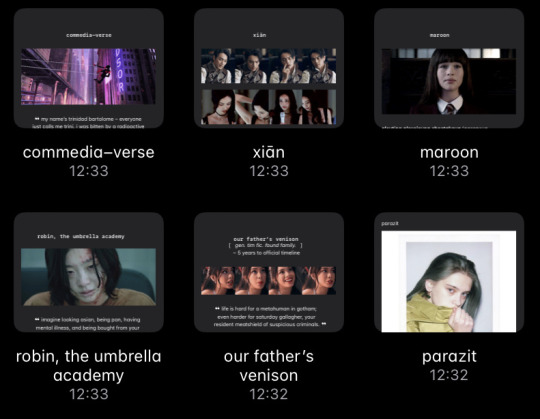
(from left to right: spiderverse oc fic, eternals oc fic, mcu shostakova!oc fic, umbrella academy oc fic, batman meta!oc fic, mcu hydra!oc fic — with their own faceclaims and a wikipedia-esque formatting because that what i’m most comfortable with using.)




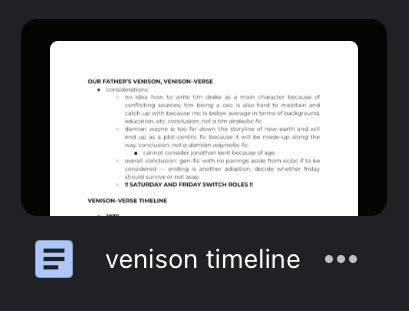
(from left to right: shinto pjo, star wars oc, sandman + batman oc, mcu + harry potter stark!oc, venom oc, batman oc timeline)
they’re plots i will probably never pick up again but will consider coming back to in the future. everybody has their own fair share of stories they want to write but can never pick up again but my advice is to jot it down, come back to it when you can, then just take your time. don’t force yourself to write. literally DON’T. you’re just going to get burnt out and that’s the last thing you’d want.
motivation isn’t something you can just pick up out of nowhere. it takes time. it’ll also help reading books and watching movies, look for other artistic inspiration. then just work your way around it :D that’s what i usually do.
but when the inspiration strikes, literally GRAB it. like fr, just grab it and start writing because you don’t know when it’s going to come back again!
#問 ━━ answers#i hope this helped 🧍🏻♀️#i also exposed myself and my wips here...#writing advices#writing tips#fanfiction
5 notes
·
View notes
Text
Honestly? My main piece of advice for writing well-rounded characters is to make them a little bit lame. No real living person is 100% cool and suave 100% of the time. Everyone's a little awkward sometimes, or gets too excited about something goofy, or has a silly fear, or laughs about stupid things. Being a bit of a loser is an incurable part of the human condition. Utilize that in your writing.
#this is my beef with a lot of 'badass' characters and male romantic leads tbh#writeblr#writing#character writing#writing advice#characters#i'm just sayin'
43K notes
·
View notes
Text
A general cane guide for writers and artists (from a cane user, writer, and artist!)
Disclaimer: Though I have been using a cane for 6 years, I am not a doctor, nor am I by any means an expert. This guide is true to my experience, but there are as many ways to use a cane as there are cane users!
This guide will not include: White canes for blindness, crutches, walkers, or wheelchairs as I have no personal experience with these.
This is meant to be a general guide to get you started and avoid some common mishaps/misconceptions in your writing, but you absolutely should continue to do your own research outside of this guide!
This is NOT a medical resource!!! And never tell a real person you think they're using a cane wrong!

The biggest recurring problem I've seen is using the cane on the wrong side. The cane goes on the opposite side of the pain! If your character has even-sided pain or needs it for balance/weakness, then use the cane in the non-dominant hand to keep the dominant hand free. Some cane users also switch sides to give their arm a rest!
A cane takes about 20% of your weight off the opposite leg. It should fit within your natural gait and become something of an extension of your body. If you need more weight off than 20%, then crutches, a walker, or a wheelchair is needed.
Putting more pressure on the cane, using it on the wrong side, or having it at the wrong height can make it less effective, and can cause long term damage to your body from improper pressure and posture. (Hugh Laurie genuinely hurt his body from years of using a cane wrong on House!)
(some people elect to use a cane wrong for their personal situation despite this, everyone is different!)
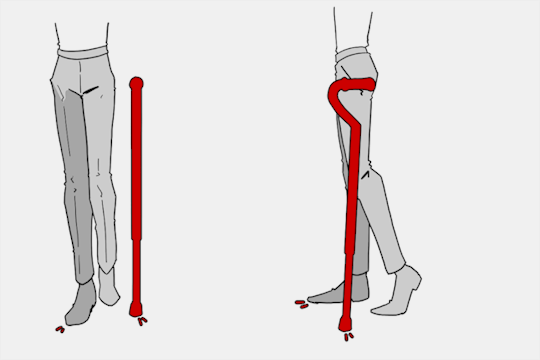
(an animated GIF of a cane matching the natural walking gait. It turns red when pressure is placed on it.)
When going up and down stairs, there is an ideal standard: You want to use the handrail and the cane at the same time, or prioritize the handrail if it's only on one side. When going up stairs you lead with your good leg and follow with the cane and hurt leg together. When going down stairs you lead with the cane and the bad leg and follow with the good leg!
Realistically though, many people don't move out of the way for cane users to access the railing, many stairs don't have railings, and many are wet, rusty, or generally not ideal to grip.
In these cases, if you have a friend nearby, holding on to them is a good idea. Or, take it one step at a time carefully if you're alone.
Now we come to a very common mistake I see... Using fashion canes for medical use!
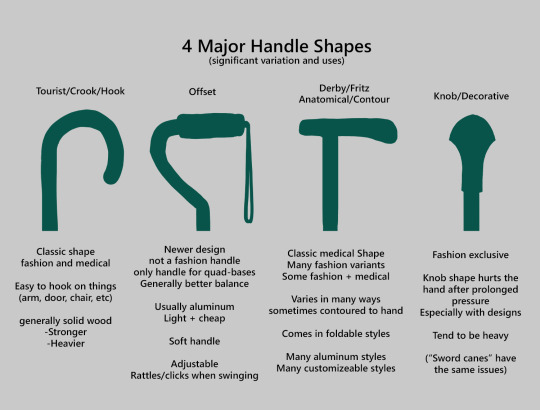
(These are 4 broad shapes, but there is INCREDIBLE variation in cane handles. Research heavily what will be best for your character's specific needs!)
The handle is the contact point for all the weight you're putting on your cane, and that pressure is being put onto your hand, wrist, and shoulder. So the shape is very important for long term use!
Knob handles (and very decorative handles) are not used for medical use for this reason. It adds extra stress to the body and can damage your hand to put constant pressure onto these painful shapes.
The weight of a cane is also incredibly important, as a heavier cane will cause wear on your body much faster. When you're using it all day, it gets heavy fast! If your character struggles with weakness, then they won't want a heavy cane if they can help it!
This is also part of why sword canes aren't usually very viable for medical use (along with them usually being knob handles) is that swords are extra weight!
However, a small knife or perhaps a retractable blade hidden within the base might be viable even for weak characters.
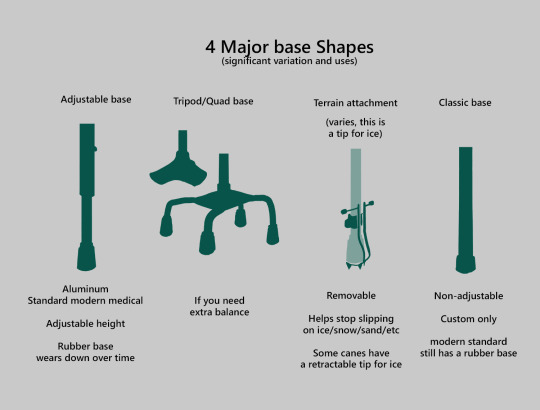
Bases have a lot of variability as well, and the modern standard is generally adjustable bases. Adjustable canes are very handy if your character regularly changes shoe height, for instance (gotta keep the height at your hip!)
Canes help on most terrain with their standard base and structure. But for some terrain, you might want a different base, or to forego the cane entirely! This article covers it pretty well.
Many cane users decorate their canes! Stickers are incredibly common, and painting canes is relatively common as well! You'll also see people replacing the standard wrist strap with a personalized one, or even adding a small charm to the ring the strap connects to. (nothing too large, or it gets annoying as the cane is swinging around everywhere)
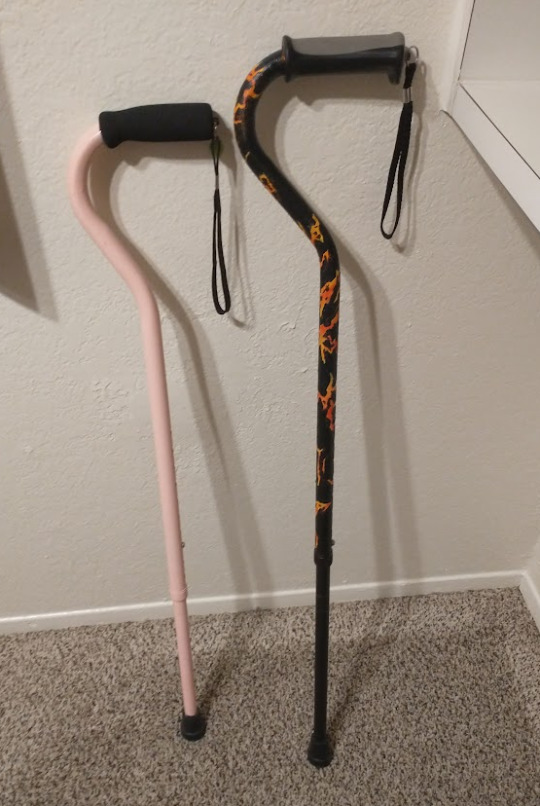
(my canes, for reference)
If your character uses a cane full time, then they might also have multiple canes that look different aesthetically to match their outfits!
When it comes to practical things outside of the cane, you reasonably only have one hand available while it's being used. Many people will hook their cane onto their arm or let it dangle on the strap (if they have one) while using their cane arm, but it's often significantly less convenient than 2 hands. But, if you need 2 hands, then it's either setting the cane down or letting it hang!
For this reason, optimizing one handed use is ideal! Keeping bags/items on the side of your free hand helps keep your items accessible.

When sitting, the cane either leans against a wall or table, goes under the chair, or hooks onto the back of the chair. (It often falls when hanging off of a chair, in my experience)
When getting up, the user will either use their cane to help them balance/support as they stand, or get up and then grab their cane. This depends on what it's being used for (balance vs pain when walking, for instance!)
That's everything I can think of for now. Thank you for reading my long-but-absolutely-not-comprehensive list of things to keep in mind when writing or drawing a cane user!
Happy disability pride month! Go forth and make more characters use canes!!!
#mobility aid#cane user#writing tips#writing advice#drawing tips#art tutorial#art tips#art reference#art resources#art help#my art#long post
73K notes
·
View notes
Text
Expanding a thought from a conversation this morning:
In general, I think "Is X out-of-character?" is not a terribly useful question for a writer. It shuts down possibility, and interesting directions you could take a character.
A better question, I believe, is "What would it take for Character to do X?" What extremity would she find herself in, where X starts to look like a good idea? What loyalties or fears leave him with X as his only option? THAT'S where a potentially interesting story lies.
In practice, I find that you can often justify much more from a character than you initially dreamed you could: some of my best stories come from "What might drive Character to do [thing he would never do]?" As long as you make it clear to the reader what the hell pushed your character to this point, you've got the seed of a compelling story on your hands.
#writing#writing advice#my writing#I think 'ooc' is a bogeyman that casts too big a shadow for fanfic writers#stop thinking 'is this ooc?'#and start thinking 'have I given this character a good enough reason to do the thing?'
49K notes
·
View notes
Text
Hey! Are there blacksmiths in your story? I'm a hobbyist blacksmith and I'm here to help!
Blacksmithing is one of those things that a lot of people get wrong because they don't realize it stuck around past the advent of the assembly line. Here's a list of some common misconceptions I see and what to do instead!
Not all blacksmiths are gigantic terrifying muscly guys with beards and deep voices. I am 5'8, skinny as a twig, have the muscle mass of wet bread, and exist on Tumblr. Anybody who is strong enough to pick up a hammer and understands fire safety can be a blacksmith.
You can make more than just swords with blacksmithing. Though swords are undeniably practical, they're not the only things that can be made. I've made candle holders, wall hooks, kebab skewers, fire pokers, and more. Look up things other people have made, it's really amazing what can be done.
"Red-hot" is actually not that hot by blacksmith terms. when heated up, the metal goes from black, to red, to orange, to yellow, to white. (for temperature reference, I got a second degree burn from picking up a piece of metal on black heat) The ideal color to work with the metal is yellow. White is not ideal at all, because the metal starts sparking and gets all weird and lumpy when it cools. (At no point in this process does the metal get even close to melting. It gets soft enough to work with, but I have never once seen metal become a liquid.)
Blacksmithing takes fucking forever. Not even taking into account starting the forge, selecting and preparing metal, etc. etc. it takes me around an hour to make one (1) fancy skewer. The metals blacksmiths work with heat up and cool down incredibly fast. When the forge is going good, it only takes like 20 seconds to get your metal hot enough to work with, but it takes about the same time for it to cool down, sometimes even less.
As long as you are careful, it is actually stupidly easy to not get hurt while blacksmithing. When I picked up this hobby I was like "okay, cool! I'm gonna make stuff, and I'm gonna end up in the hospital at some point!" Thus far, the latter has yet to occur. I've been doing this for nearly a year. I have earned myself a new scar from the aforementioned second degree burn, and one singe mark on my jeans. I don't even wear gloves half the time. Literally just eye protection, common sense, and fast reflexes and you'll probably be fine. (Accidents still happen of course, but I have found adequate safety weirdly easy to achieve with this hobby)
A forge is not a fire. The forge is the thing blacksmiths put their metal in to heat it up. It starts as a small fire, usually with newspaper or something else that's relatively small and burns easily, which we then put in the forge itself, which is sort of a fireplace-esque thing (there's a lot of different types of forge, look into it and try to figure out what sort of forge would make the most sense for the context you're writing about) and we cover it with coal, which then catches fire and heats up. The forge gets really hot, and sometimes really bright. Sometimes when I stare at the forge for too long it's like staring into the sun. The forge is also not a waterfall of lava, Steven Universe. It doesn't work like that, Steven Universe.
Welding and blacksmithing are not the same thing. They often go hand-in-hand, but you cannot connected two pieces of metal with traditional blacksmithing alone. There is something called forge welding, where you heat your metal, sprinkle borax (or the in-universe equivalent) on it to prevent the metal from oxidizing/being non-weldable, and hammer the pieces together very quickly. Forge welding also sends sparks flying everywhere, and if you're working in a small space with other blacksmiths, you usually want to announce that you're welding before you do, so that everyone in a five-foot radius can get out of that five-foot radius. You also cannot just stuck some random pebbles into the forge and get a decent piece of metal that you can actually make something with, Steven Universe. It doesn't work like that, Steven Universe.
Anvils are really fucking heavy. Nothing else to add here.
Making jewelry is not a blacksmithing thing unless you want jewelry made of steel. And it will be very ugly if you try. Blacksmithing wasn't invented to make small things.
If there's anything here I didn't mention, just ask and I'll do my best to answer.
#yes some of this was directed at steven universe#the only thing su got right was bismuth crying when her anvil broke#cus those things are goddamn expensive and hard to transport#blacksmith#blacksmithing#writing#writing prompts#writing advice#writeblr#writer#writer problems#writerblr#writerscommunity#writers on tumblr#writers and poets#writers
35K notes
·
View notes
Text
If you want to write a dumb little story with a dumb little plot and ridiculously silly characters. No one's stopping you. Genuinely, no one should be allowed to stop you. Write that dumb story with your whole heart and don't hold back.
#look I've deleted fics that made me feel awful#There's a time and a place#A good idea will come back to you again#But some things should be given time to settle#writeblr#writing tips#writing#writer advice#writers on tumblr
71K notes
·
View notes
Text
The symbolism of flowers
Flowers have a long history of symbolism that you can incorporate into your writing to give subtext.
Symbolism varies between cultures and customs, and these particular examples come from Victorian Era Britain. You'll find examples of this symbolism in many well-known novels of the era!
Amaryllis: Pride
Black-eyed Susan: Justice
Bluebell: Humility
Calla Lily: Beauty
Pink Camellia: Longing
Carnations: Female love
Yellow Carnation: Rejection
Clematis: Mental beauty
Columbine: Foolishness
Cyclamen: Resignation
Daffodil: Unrivalled love
Daisy: Innocence, loyalty
Forget-me-not: True love
Gardenia: Secret love
Geranium: Folly, stupidity
Gladiolus: Integrity, strength
Hibiscus: Delicate beauty
Honeysuckle: Bonds of love
Blue Hyacinth: Constancy
Hydrangea: Frigid, heartless
Iris: Faith, trust, wisdom
White Jasmine: Amiability
Lavender: Distrust
Lilac: Joy of youth
White Lily: Purity
Orange Lily: Hatred
Tiger Lily: Wealth, pride
Lily-of-the-valley: Sweetness, humility
Lotus: Enlightenment, rebirth
Magnolia: Nobility
Marigold: Grief, jealousy
Morning Glory: Affection
Nasturtium: Patriotism, conquest
Pansy: Thoughtfulness
Peony: Bashfulness, shame
Poppy: Consolation
Red Rose: Love
Yellow Rose: Jealously, infidelity
Snapdragon: Deception, grace
Sunflower: Adoration
Sweet Willian: Gallantry
Red Tulip: Passion
Violet: Watchfulness, modesty
Yarrow: Everlasting love
Zinnia: Absent, affection
#writers#creative writing#writing community#writing#writers of tumblr#writing inspiration#creative writers#writeblr#writerblr#writing tips#flower symbolism#writing subtext#writblr#writers corner#how to write subtext#symbolism in writing#writing advice#creative writing tips#writing resources#writing help#writer tips#writing tips and tricks#helping writers#help for writers#references for writers#writing reference#writers block#beat writers block#novel writing
48K notes
·
View notes
Note
I read your post about not letting kudos and hits upset us. I try to think this way but I'm curious about something else. I've written many fanfics for my fandom and they're all "flop". I don't mind that honestly. But then some writers have written only one fic about the ship I do and and it gets hundreds of kudos. How do some writers achieve that when I'm doing the same and it doesn't get the same response. What else can I do?
I’m afraid I can’t give you a definite answer about what you should do or why this person’s work is more popular, but what I can give you are some advice and, from my experience, some reasons that might explain why other’s works receive more hits and kudos.
start with why other writers’ works are more popular when it’s the same characters, same ship, same fandom. there are various factors at play that might be it;
maybe the person already has large audience base prior to their posting about the fandom you’re in, I know a few authors who already have these sorts of loyal readers that would read any work the authors posted even if they (the readers) were not in that fandom.
maybe someone, anyone, decided share the link to this person’s work on Tumblr or Twitter (X) or any social media platform, and it kind of became viral, thus it drew in lots and lots of readers. it could take just one person, didn’t necessarily have to be the author themself, to share the link among the fandom as a recommendation, or maybe a screenshot of one sentence from the fic that they liked, what happened next is that the replies were filled with people asking for the link.
tags and summary are important factors when people are looking for a fic to read. so maybe this person’s work is tagged with the content people were looking for? maybe their summary grabbed people’s attention or curiosity?
these are just what I can think of over the top of my head.
as for what you can do to gain more readers, I’ve never seen your work so the advice I can give will be a general one; I believe the trick lies in summary, tags as well as the format of one’s work.
when it comes to AO3 (I assume it’s your platform?), tags and summary are the main things people use to determine whether or not they want to click on the fic.
tag your content properly, what characters or pairings it’s about, as well as what the readers will find upon reading your work (you don’t have to spoil it, only the general tags that will give your readers an idea of what they’re in for).
summaries are just as important. there are no “rules” obviously, and I’m not telling you or any writers what to do. though a little advice that I personally take is that you use this little summary section AO3 gives you to do anything to make sure it stands out and that people will see it and want to click on it. that means leave “author’s note” out of the summary section. folks, AO3 summary is the first glimpse into the fic itself that people will see prior to clicking on it, most of the time, people look at the summary to see the author’s writing style and if what’s written, plotwise, grabs their interest. personally, when I see an author use “summary” as a place to write “author’s note”, chances are, I will scroll past that fic as I am interested in what the fic is about, not what the author has to say about their opinion on said fic or their personal life or anything (there’s an author’s note section for that) and if I can’t get a glimpse of what the plot is about or what the author’s writing style is from the summary section, then I won’t click on it, and will look for other fic that can get me interested instead.
moving on to fic format, again, I am not telling anyone what to do here. this is only a suggestion, an advice I’ve learned and want to share: when you write your fic, make sure to use line and paragraph spacing. if your 10k word long fic is one long block of text with no paragraph break, chances are, people will back away from it entirely. also, if it’s two different characters talking with dialogues, don’t put all of their dialogues in one paragraph. for instance, a paragraph for character A’s dialogue, then another separate paragraph for character B’s dialogue and so on.
and I think that’s it for my advice? however, I’ll say this again that the secret to truly enjoying your role as a fanfic writer is that you only focus on yourself. write whatever you want for yourself. it doesn’t matter if this person’s work is more popular, because fanfics and fandoms aren’t a competition. you are your main audience. just have fun creating the stories you want to create for you.
#admin answers#writing tips#writing tip#whump#writing#writer#writeblr#ao3#archive of our own#whumpblr#writing advice#writing advices#how to ao3#writers#writing challenge#writing inspo#writing inspiration#blorbo#comfort character#whump community#fanfic#fanfiction#fandom#fandoms
77 notes
·
View notes
Text
Pirate Terms and Phrases
-> Pirate Lingo
-> A Pirate's Glossary
Batten Down The Hatches - tie everything down and put stuff away for a coming storm.
Brig - a prison on a ship.
Bring a Spring Upon 'er - turn the ship in a different direction
Broadside - the most vulnerable angle of a ship that runs the length of the boat.
Cutlass - a thick, heavy and rather short sword blade.
Dance with Jack Ketch - to hang; death at the hands of the law (Jack Ketch was a famed English executioner).
Davy Jones's Locker - a mythical place at the bottom of the ocean where drowned sailors are said to go.
Dead Men Tell No Tales - the reason given for leaving no survivors.
Flogging - severe beating of a person.
Gangplank - removable ramp between the pier and ship.
Give No Quarter - show no mercy.
Jack - flag flown at the front of the ship to show nationality.
Jolly Roger - black pirate flag with a white skull and crossbones.
Keelhaul - a punishment where someone is dragged under the ship. They are cut by the planks and barnacles on the bottom of the ship.
Landlubber - an inexperienced or clumsy person who doesn't have any sailing skills.
Letters of Marque - government-issued letters allowing privateers the right to piracy of another ship during wartime.
Man-O-War - a pirate ship that is decked out and prepared for battle.
Maroon - to leave someone stranded on a. deserted island with no supplies, typically a punishment for any crew members who disrespected the captain.
Mutiny - a situation in which the crew chooses a new captain, sometimes by forcibly removing the old one.
No Prey, No Pay - a common pirate law that meant crew members were not paid, but rather received a share of whatever loot was taken.
Old Salt - experienced pirate or sailor.
Pillage - to steal/rob a place using violence.
Powder Monkeys - men that performed the most dangerous work on the ship. They were treated harshly, rarely paid, and were expendable.
Privateer - government-appointed pirates.
Run A Shot Across the Bow - fire a warning shot at another boat's Captain.
Scurvy - a disease caused by Vitamin C Deficiency.
Sea Legs - when a sailor adjusts his balance from riding on a boat for a long time.
Strike Colors - lower a ship's flag to indicate surrender.
Weigh Anchor and Hoist the Mizzen - an order to the crew to pull up the anchor and get the ship sailing.
If you like what I do and want to support me, please consider buying me a coffee! I also offer editing services and other writing advice on my Ko-fi! Become a member to receive exclusive content, early access, and prioritized writing prompt requests.
#creative writing#writeblr#pirate writing prompts#pirates#pirate au#glossary#pirate lingo#pirate terms and phrases#pirate language#pirate vocab#pirate vocabulary#victorian slang#how to talk like a pirate#how to write#writing tips#fiction writing#writing advice#writing help#writing resources
12K notes
·
View notes
Text
This is a friendly reminder to give your OC a firm and unmistakable L every now and then.
This is a necessary action to keep your OC healthy for the long term.
#oc#oc writing#oc wip#writing advice#writing process#creative writing#writers on tumblr#writing#writers#writers on ao3#ao3#writeblr#writing community#writing help
20K notes
·
View notes
Text
I just saw a post on Tumblr asking if you're "allowed" to do something in a story you're writing. (In this case, a POV shift.)
I just want to sing to the tune of Beethoven's Fifth Symphony, "THERE ARE NO RULES. THERE ARE NO RULES. There are no rules there are no rules there are no rules..."
29K notes
·
View notes
Text
Good Traits Gone Bad
Exploring good traits gone bad in a novel can add depth and complexity to your characters. Here are a few examples of good traits that can take a negative turn:
1. Empathy turning into manipulation: A character with a strong sense of empathy may use it to manipulate others' emotions and gain an advantage.
2. Confidence becoming arrogance: Excessive confidence can lead to arrogance, where a character belittles others and dismisses their opinions.
3. Ambition turning into obsession: A character's ambition can transform into an unhealthy obsession, causing them to prioritize success at any cost, including sacrificing relationships and moral values.
4. Loyalty becoming blind devotion: Initially loyal, a character may become blindly devoted to a cause or person, disregarding their own well-being and critical thinking.
5. Courage turning into recklessness: A character's courage can morph into reckless behavior, endangering themselves and others due to an overestimation of their abilities.
6. Determination becoming stubbornness: Excessive determination can lead to stubbornness, where a character refuses to consider alternative perspectives or change their course of action, even when it's detrimental.
7. Optimism becoming naivety: Unwavering optimism can transform into naivety, causing a character to overlook dangers or be easily deceived.
8. Protectiveness turning into possessiveness: A character's protective nature can evolve into possessiveness, where they become overly controlling and jealous in relationships.
9. Altruism becoming self-neglect: A character's selflessness may lead to neglecting their own needs and well-being, to the point of self-sacrifice and burnout.
10. Honesty becoming brutal bluntness: A character's commitment to honesty can turn into brutal bluntness, hurting others with harsh and tactless remarks.
These examples demonstrate how even admirable traits can have negative consequences when taken to extremes or used improperly. By exploring the complexities of these traits, you can create compelling and multi-dimensional characters in your novel.
Happy writing!
#character traits#writing#writing tips#character development#writer on tumblr#writerscommunity#writer tumblr#writblr#writing advice#oc character#writing help#creative writing
51K notes
·
View notes
Text
Because you deserve to get back just as much of the love you pour into the world.
k.b. // you do
#k.b.#quotes#poets on tumblr#writers on tumblr#love#love quotes#quote#words#love quote#cute#deep thoughts#i love you#life#life quotes#writers#life lesson#life lesson quotes#poetry#poem#writing#poets#love poem#life poem#life advice#lit#deep#deep quotes#give and take
9K notes
·
View notes
Text
Yay, unsolicited advice time! Or, not really advice, more like miscellaneous tips and tricks, because if there's one thing eight years of martial arts has equipped me to write, it's fight scenes.
.
Fun things to add to a fight scene (hand to hand edition)
It's not uncommon for two people to kick at the same time and smack their shins together, or for one person to block a kick with their shin. This is called a shin lock and it HURTS like a BITCH. You can be limping for the rest of the fight if you do it hard enough.
If your character is mean and short, they can block kicks with the tip of their elbow, which hurts the other guy a lot more and them a lot less
Headbutts are a quick way to give yourself a concussion
If a character has had many concussions, they will be easier to knock out. This is called glass jaw.
Bad places to get hit that aren't the groin: solar plexus, liver, back of the head, side of the thigh (a lot of leg kicks aim for this because if it connects, your opponent will be limping)
Give your character a fighting style. It helps establish their personality and physicality. Are they a grappler? Do they prefer kicks or fighting up close? How well trained are they?
Your scalp bleeds a lot and this can get in your eyes, blinding you
If you get hit in the nose, your eyes water
Adrenaline's a hell of a drug. Most of the time, you're not going to know how badly you've been hurt until after the fact
Even with good technique, it's really easy to break toes and fingers
Blocking hurts, dodging doesn't
.
Just thought these might be useful! If you want a more comprehensive guide or a weapons edition, feel free to ask. If you want, write how your characters fight in the comments!
Have a bitchin day <3
12K notes
·
View notes